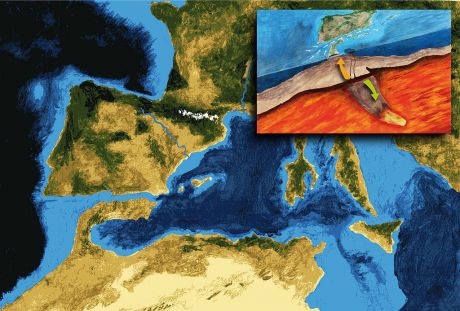Taking the pulse of the Earth

Messinian_salinity_crisis_6_mya_stage_-_last_canal
By Paubahi (Own work) [CC BY-SA 3.0 (http://creativecommons.org/licenses/by-sa/3.0)], via Wikimedia Commons
To EU-funded Earth scientists, it is evident that many parts of the Earth's crust have been extracted from the underlying mantle. However, the timing of new crust formation and recycling of old crust has proven to be an elusive issue.
Osmium-Legierungen haben den Wissenschaftler, die am OS.EARTH-Projekt
(Osmium alloys & the pulse of the Earth) arbeiten, ein Mittel zur
Untersuchung der Mantel-Kruste-Interaktion an die Hand gegeben. Osmium
kommt im Erdmantel konzentriert vor, scheint aber in der Kruste fast
erschöpft zu sein. In der Tat sind die Werte in der Kruste so niedrig,
dass sie extrem schwierig zu messen sind.
Osmium, wie Iridium, wird in höchsten Konzentrationen in magmatischen Einlagen und Einlagen aus früheren Strukturen gefunden. Innerhalb der ersten 24 Monate des OS.EARTH-Projekt sammelte das Team mehr als 300 winzige KörneOsmium alloys offered scientists working on the OS.EARTH (Osmium alloys
& the pulse of the Earth) project a means of studying the
mantle-crust interaction. Osmium is concentrated in the mantle but seems
to have almost depleted in the crust. In fact, crustal levels are so
low that they are extremely difficult to measure.
Osmium, like iridium, is found at the highest concentrations in igneous deposits and deposits reworked from former structures. Within the first 24 months of the OS.EARTH project, the team collected more than 300 tiny grains of osmium alloys from the Rhine River and others from beach placer deposits.
This crustal osmium has high radiogenic-to-stable ratios while the same mantle values are low. Its decay is unique in its ability to track the disproportionate amount of crust of certain ages. Specifically, OS.EARTH scientists confirmed that one of the main peaks was 1.2 billion years old.
Such a peak in continental crust age indicates that the Earth's crust has grown through time in pulses, coinciding with large-scale mantle melting events. Many more samples are waiting to be analysed and could provide valuable insights into earlier Earth history.
Osmium alloys collected from alluvial deposits that are mixed with gold are expected to yield invaluable clues about the formation of the Earth's continental crust. OS.EARTH scientists have been testing the hypothesis that osmium alloys in prehistoric gold objects can be used to pinpoint the source location with high accuracy.on Osmium-Legierungen aus dem Rhein und andere aus Seifeneinlagen.
Dieses Krustenosmium besitzt eine hohe Ration zwischen Radio gen und stabil während die gleichen Werte im Mantel niedrig sind. Sein Zerfall ist einmalig, da es die Fähigkeit besitzt, den unverhältnismäßig hoher Anteil der Kruste von bestimmten Alter zu verfolgen. Insbesondere bestätigten die Forscher von OS.EARTH, dass einer der Hauptpeaks 1,2 Milliarden Jahre alt war.
Solch ein Höhepunkt im kontinentalen Krustenalter zeigt, dass die Erdkruste mit der Zeit in Impulsen gewachsen war, zeitgleich mit großen Mantelschmelzereignissen. Viele weitere Proben warten darauf, untersucht zu werden und konnten wertvolle Einblicke in die frühere Erdgeschichte liefern.
Osmium-Legierungen, die aus alluvialen Ablagerungen gesammelt wurden, und mit Gold gemischt sind, sollen wertvolle Hinweise auf die Bildung der kontinentalen Erdkruste ergeben. Die Wissenschaftler von OS.EARTH testen die Hypothese, dass Osmium-Legierungen in prähistorischen Goldobjekten dazu verwendet werden können, den ursprünglichen Herkunftsort mit hoher Genauigkeit zu ermitteln.
published: 2016-02-01

